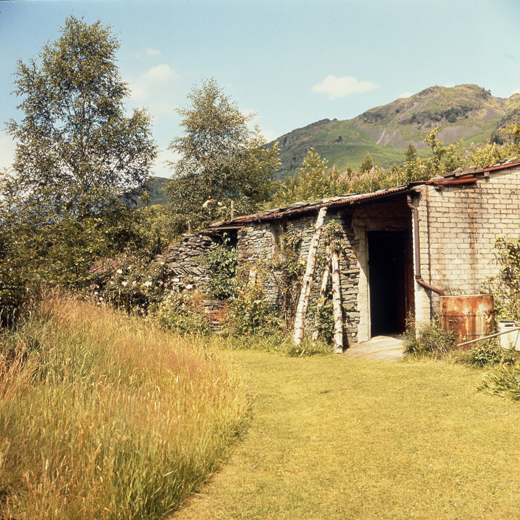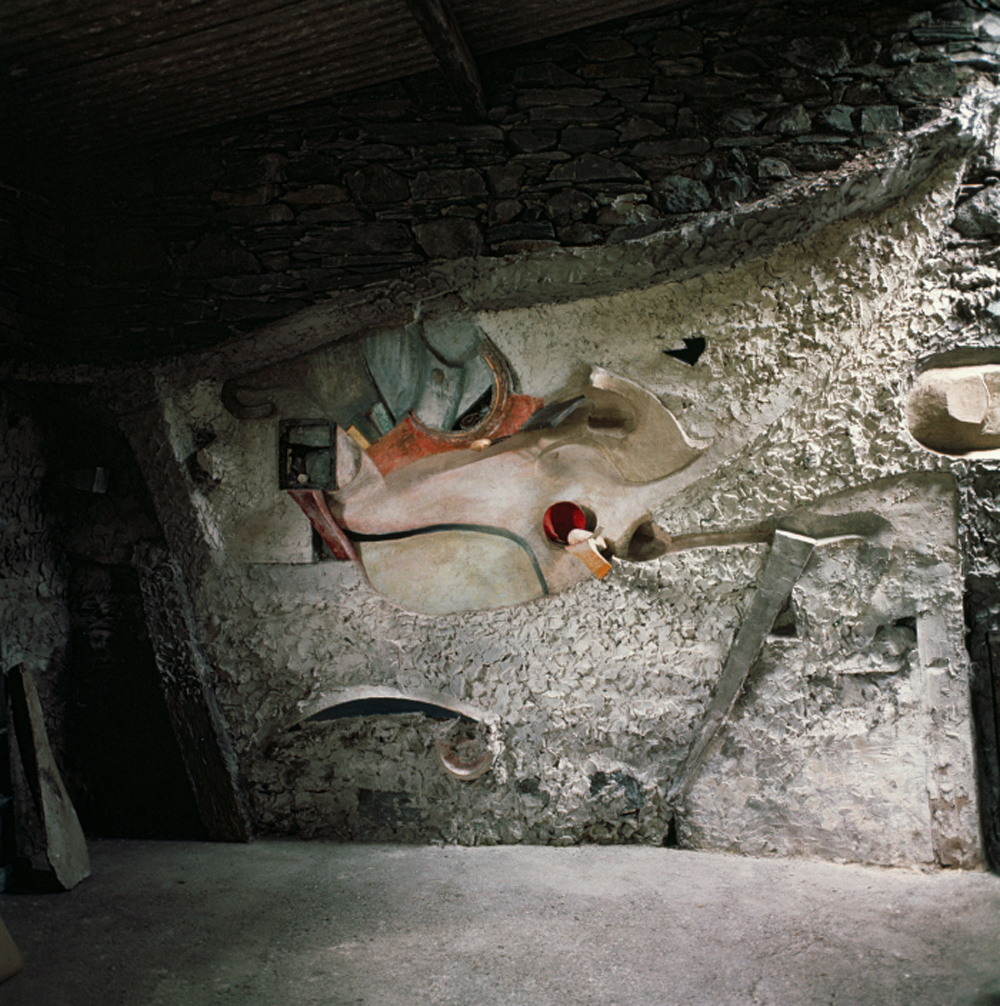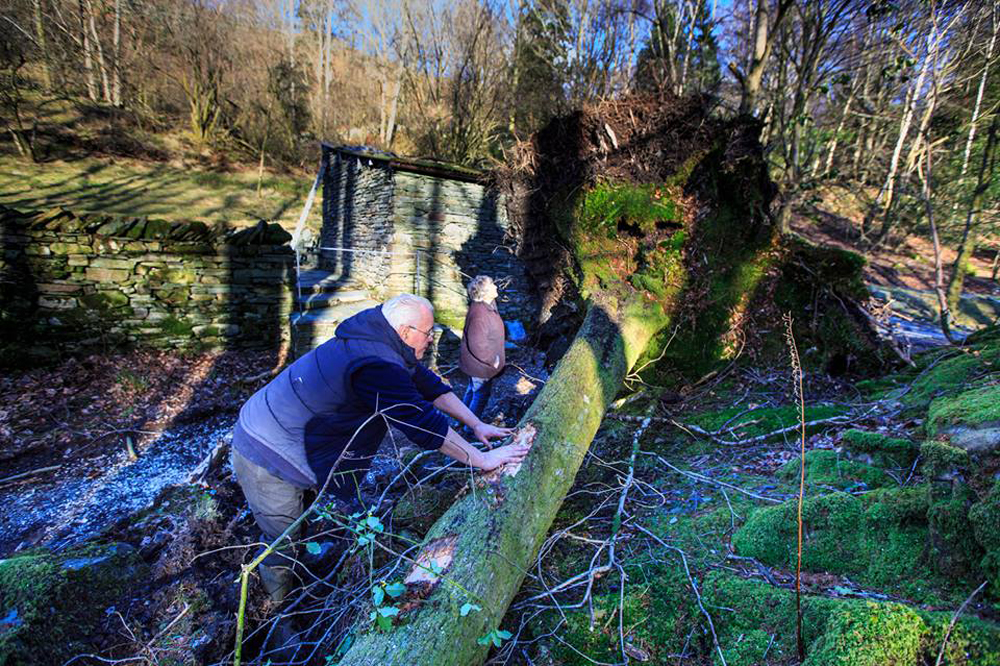The house that dada built
One hundred years since the birth of dada, what does the future hold for Kurt Schwitters’s Merz Barn in Cumbria?
One hundred years since the birth of dada, what does the future hold for Kurt Schwitters’s Merz Barn in Cumbria?

November 18, 2015. Rain-flecked mobile phone footage on YouTube follows the cascades of Aira Force in the Lake District in the north-west of England. This typically picturesque waterfall, which makes cameo appearances in several of William Wordsworth’s poems, looks as if it might sweep away the bridge below. It’s one of the wettest and warmest British winters on record. Just over a month later, on the London Review of Books blog, Huw Lemmey writes of treading carefully across a bridge at the top of the falls. He recognizes Aira as a symbol of the convergence of austerity, negligence and an outmoded attachment to a romanticized rural ideal that enabled Storms Desmond and Eva – unhelpfully anthropomorphized by the Met Office as a benign elderly couple – to wreak widespread havoc across the region throughout December (‘In Cumbria’, 30 December 2015).
Local MPs Tim Farron and Rory Stewart were, Lemmey notes, quick to don their wellies and ‘strike heroic poses’ in reconstruction work. Yet both oppose allowing increased upland vegetation growth and reforestation, measures which, argues Lemmey – citing an experiment by the Forestry Commission, United Utilities and the National Trust in a nearby part of Cumbria – would have helped lessen the surge of flood water which hit towns.

‘Farron and Stewart’s opposition lies in the obsession with maintaining a very specific idea of “nature” in the Lake District: an idea stuck in the 19th century, when the bare uplands had been thoroughly degraded by sheep farming’, says Lemmey. Stewart’s dismissal of the scientific management of upland areas is based on an, ‘outdated caricature of Cumbrianness’ – an evocation of tradition that masks the subsidy-dependence that shaped upland farming. Romantic visions, Lemmey concludes, may be best left to poetry and museums, such as Wordsworth House museum in Cockermouth, which, due to flood damage, has been closed since December (it is set to reopen later this month).
The Lake District national park is one of the country’s leading tourist attractions. At the end of January, David Cameron announced a GBP£2 million fund to repair infrastructure in the national park damaged by the December storms. Highlighting the region’s nationally important cultural and heritage sites, he pledged a further GBP£1 million for a PR campaign to persuade tourists to visit the north of England during the Easter holidays (sums deemed ‘totally inadequate’ by the Labour leader of Cumbria County Council).
Less than 20 miles south of Aira Force, it remains to be seen whether the site of Kurt Schwitters’s Merz Barn on the Cylinders Estate in Langdale will be ready to reopen by Easter. The site is strewn with trees downed in December. During the worst of the storms, all of the barn’s windows were broken, including a skylight, which led to flooding, and an adjoining wall partly collapsed when a spring opened in the bank behind it. Time is running out. Littoral Arts Trust, who own and manage the site, recently wrote a letter inviting David and Samantha Cameron to visit the Merz Barn when they do their bit for the local economy by holidaying in the Lake District later next month. How does the legacy of Schwitters speak to a convergence of austerity, negligence and romanticism specific to the Lake District?

It was Schwitters’s encounter with the Berlin dadaists, particularly Hans Arp, Raoul Hausmann, and Hannah Höch, in 1918 that influenced the ‘Merz’ collages he is best known for today. Consisting of discarded scraps of paper and objects, ‘Merz’, the second syllable of the word ‘Commerz’, was appropriated from a found fragment of text, in full ’Commerz und Privatbank’, that Schwitters used in a collage of 1919. Semantically bound to commerce, ‘Merz’ revalued the detritus of capitalism, while retaining, for Schwitters, an obscene sense of the word ‘shit’. ‘Merz’ became a prefix for many projects, including his Merzbauten, the most significant of which he began constructing in his parents’ Hanover house in 1932. Like a living organism, the sculptural installation grew month by month, incorporating found objects in its many chambers, until it broke through a skylight, exceeding the limits of its host structure. When Schwitters’ art was included in the Nazi ‘Entartete Kunst’ (Degenerate Art Exhibition) in 1936 (ironically, one of the most important exhibitions of continental avant garde art), he fled to Lysaker, near Olso, where he began work on a new Merzbau. When the Nazis invaded Norway, Schwitters fled again, to Scotland, only to be held as a refugee in various internment camps around the British Isles. Following the war, and a brief period in London, he moved to the Lake District where, in 1947, he began his last Merzbau. In 1936 the Hanover Merzbau had been destroyed in a bombing raid; in 1951 the Merzbau in Lysaker was destroyed by a fire. This, the ‘Elterwater Merz Barn’ as it’s sometimes known, would be his enduring legacy.
Asked what will happen if emergency repairs are not undertaken, Ian Hunter, the director of Littoral, explained that the barn will continue to deteriorate and the end wall of the building is likely to collapse. The Merz Barn project has, in the past, received substantial funding from the Arts Council. It’s also been the recipient of a lot of good will. In 2006, an auction of works donated by renowned international artists – among them Tacita Dean, Damien Hirst and Bridget Riley – enabled the trust to purchase the site. At this particular time the Arts Council maintains that its remit is not to fund restoration work. ‘We are,’ Hunter told A-N magazine recently, ‘obviously exploring other fundraising options including crowd sourcing and the possibility of some funding from the Cumbrian flood relief scheme. This is now rather unlikely, as it is only for farmers and local businesses.’

The exasperated strains of Littoral’s recent press release announcing an international ‘Save the Merz Barn campaign’ lists the many doors already closed to the organization. They’ve even invested their own money: last year the trust’s co-chair, Celia Larner, sold off part of her home to pay for the cost of repairs and damage caused by storms the previous Christmas and New Year. As the press release asks: Are we really willing, in the year of dada’s centenary celebrations and the opening of Tate Modern’s GBP£260 million extension, to let Britain’s only dada-inspired architectural experiment crumble into dust? When Tate Britain politely ‘brushed-off’ Littoral’s appeals, Littoral approached Glen Lowry, current director of the Museum of Modern Art (MoMA) in New York, asking them to support, or even take ownership of, the site. In 1947 MoMA granted Schwitters USD$1,000 to commence work on this his last of four Merzbauten, which remained unfinished when he died the following year. Why will no one now help restore the last standing Merzbau?
We were all involved with Littoral and the Merz Barn for overlapping periods between 2006 and 2008. Our engagement with the project was brief, perhaps 18 months in total – at turns intensely inspiring and intensely frustrating. At the end of summer 2008, the relationship came to an abrupt end, just as Northern Rock customers were beginning to queue anxiously at branches across the UK to draw out their life savings. Littoral, presumably anxious about how the recession might affect them, withdrew their funding for a summer school project we’d spent the past year devising. None of us was a particular Schwitters aficionado. Instead, the Merz Barn was a point of departure for, in the spirit of the German refugee’s boundary-crossing work, our shared interests in socially-engaged art (particularly outside of London), anthropology, material culture, sound art and oral culture.

The period we were involved was charged by a powerful sense of possibility. It might have been youthful élan, the forging of peer relationships in the uncertain period after university, lack of responsibility, lack of monetary drive – or even the straitened economic reality we still endure, eight years on. A sense of serious play underlined everything that went on at the Merz Barn. And the power of the absurd: we were captivated by a story of the late jazz singer George Melly frightening away muggers (or was it Black Shirts?) by bellowing Schwitters’s nonsense poem Ursonate (1922–32). We identified with Black Mountain College and a tradition of radical pedagogy then being explored by, for instance, PLATFORM, a London-based arts organization campaigning for social justice and ecological awareness.
For the First International Kurt Schwitters Autumn School, in 2007, Littoral gathered an eccentric array of art historians, experimental musicians, poets and artists in a programme that included a conference, exhibitions, performances and a community radio station devoted to Schwitters in England. Ursonate was performed at the Conservative club in the local town, Ambleside (a purposeful provocation). At the Cylinders Estate, by the Merz Barn, Rosanna Raymond performed traditional Maori songs by firelight. Florian Kaplick, a leading expert on Schwitters’s sound poetry, found a clearing and led a group recital of passages from the Ursonate. To this day we can still recite those passages – a testament to a kinaesthetic model of learning fundamental to the activities around the Merz Barn. It was chaotic and beguiling.

Schwitters is an unlikely figure in a landscape dominated by the tradition of romanticized rural idealism identified by Lemmey. The artist’s work is evasive. It’s an evasiveness at the very heart of the Merz Barn: in 1966, Richard Hamilton, with the help of a fine art student at Newcastle University, Fred Brookes, relocated the entire barn wall, clad by Schwitters’s sculptural relief, to the Hatton Gallery in Newcastle. Since then Cylinders has been a place where Schwitters’s relief – to some extent, the Merz Barn’s defining characteristic – was straining the relation between site, heritage and authenticity. Where is the Merz Barn? Where it is materially located or where it is performed? We felt the barn was a pretext for everything else that happened on the site. It seems like there are more fundamental questions about what the function of the site should be. Should it be a contemporary art institution? Or is it a site for the study of art history? It certainly isn’t a museum. If Littoral should one day realize their obsession with making it into a functioning visitors’ centre, perhaps the sculptural relief removed by Hamilton and Brookes should be returned to its original site?
When Schwitters finally settled at Cylinders he spent a significant amount of time in Ambleside and Elterwater. We met locals who regarded him as a great character: someone who, when necessary, suspended his avant-garde activity to produce Sunday-painter portraits and landscape scenes for money. The Cumbria Merz Barn was a place of refuge for an artist in exile from the Nazis, who regarded him degenerate. Britain has an admirable history of receiving refugees, not just from Germany, but numerous conflicts including the Spanish civil war and, today, amid much contestation, limited numbers of Syrians. Schwitters’s work sought to transgress boundaries of all kinds. As Europe erects borders the Merz Barn’s meaning changes once more.
Each of us spent time in Cumbria and Yorkshire (also affected by the winter storms) over the Christmas holidays, and felt a shared sense of bewilderment and anger at the ignorance and misrepresentation of Storms Desmond and Eva’s effects by London-based newspapers. These ‘once in a lifetime’ floods have become three times in a lifetime floods, and counting. Let’s help Littoral receive the Camerons this Easter. Who can say what might happen?






















